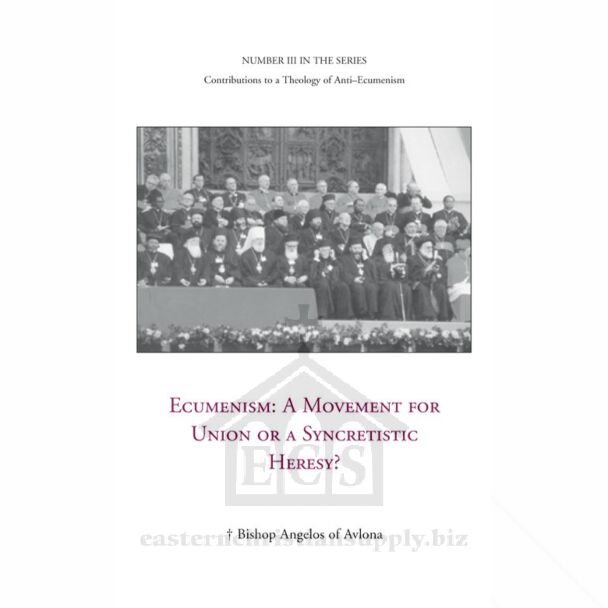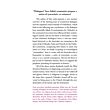Ecumenism׃ A Movement for Union or a Syncretistic Heresy?
by Bishop Angelos of Avlona
Translated by Archbishop Chrysostomos of Etna and Hieromonk Patapios
Translated by Archbishop Chrysostomos of Etna and Hieromonk Patapios
Publication Data: Etna, CA: Center for Traditionalist Orthodox Studies, 1998
Format: softcover
Number of Pages: 79
Dimensions (l × w × h): 19.7 cm × 12.1 cm × 0.4 cm
Additional Information: black-and-white illustrations
ISBN: 0‒911165‒34‒7
by Bishop Angelos of Avlona
Translated by Archbishop Chrysostomos of Etna and Hieromonk Patapios
Number III of Contributions to a Theology of Anti–Ecumenism
“[...W]hat are those presuppositions that constitute a strong foundation for Orthodox who participate in dialogues with the heterodox, such that they will be and remain strong, unaffected, and without risk from harm? We discover these presuppositions in Patristic Tradition, and they are the most fundamental principles of Orthodox ecclesiology. They are the following: First principle: There is One and only one true Church, which is ontologically identical with the Orthodox Church; every other Christian community, which is not identical or unified in faith with Orthodoxy, is heretical and outside the domain of the Truth and the Church. [...]Second principle: Only inside the One and only Church, that is, the Orthodox Church, is salvation in Christ unfailingly bestowed, because only She (the Church) is the Body of Christ, and only those who are members of His Body can be in communion with Her Head, which is Christ. [...]It should be strongly emphasized that ‘the exclusive and sole overriding consideration that governs relations between Orthodox and heretics is,’ according to Patristic Tradition, ‘the return of the latter to Orthodoxy.’”
—“A. Fundamental Ecclesiological Principles”
CONTENTS
A. Fundamental Ecclesiological Principles
B. The Petitions of Orthodoxy for the Union of the Churches
1. “For the Good Estate of the Holy Churches of God and for the Union of All”
2. “That They All May Be One”
C. Dialogues or Recognition of Heresies?
1. The First Circle: Rapprochement and Coöperation
2. The Second Circle: Ecumenical Theology
3. The Third Circle: Theological Dialogues
a. The Spectrum of the Dialogues
b. The Foundation of the Dialogues
c. Have the Dialogues Succeeded?
c1. Within the WCC
c2. They Have Led to Dead–ends
i. The Dialogue with the Old Catholics
ii. The Dialogue with the Anglicans
iii. The Dialogue with the Lutherans
c3. A Credibility Gap in the Dialogues
i. The Dialogue of the Old Catholics with the Orthodox and the Anglicans
ii. The Dialogue with the Papists (on the Subject of the Unia)
iii. Problems over Celebrations of the Unia
c4. Dogmatic “Minimalism”
i. The Dialogue with the Papists (“Sister Churches”)
ii. The Dialogue with the Monophysites (Non–Chalcedonians)
D. Recapitulation and Proposals
Format: softcover
Number of Pages: 79
Dimensions (l × w × h): 19.7 cm × 12.1 cm × 0.4 cm
Additional Information: black-and-white illustrations
ISBN: 0‒911165‒34‒7
by Bishop Angelos of Avlona
Translated by Archbishop Chrysostomos of Etna and Hieromonk Patapios
Number III of Contributions to a Theology of Anti–Ecumenism
“[...W]hat are those presuppositions that constitute a strong foundation for Orthodox who participate in dialogues with the heterodox, such that they will be and remain strong, unaffected, and without risk from harm? We discover these presuppositions in Patristic Tradition, and they are the most fundamental principles of Orthodox ecclesiology. They are the following: First principle: There is One and only one true Church, which is ontologically identical with the Orthodox Church; every other Christian community, which is not identical or unified in faith with Orthodoxy, is heretical and outside the domain of the Truth and the Church. [...]Second principle: Only inside the One and only Church, that is, the Orthodox Church, is salvation in Christ unfailingly bestowed, because only She (the Church) is the Body of Christ, and only those who are members of His Body can be in communion with Her Head, which is Christ. [...]It should be strongly emphasized that ‘the exclusive and sole overriding consideration that governs relations between Orthodox and heretics is,’ according to Patristic Tradition, ‘the return of the latter to Orthodoxy.’”
—“A. Fundamental Ecclesiological Principles”
CONTENTS
A. Fundamental Ecclesiological Principles
B. The Petitions of Orthodoxy for the Union of the Churches
1. “For the Good Estate of the Holy Churches of God and for the Union of All”
2. “That They All May Be One”
C. Dialogues or Recognition of Heresies?
1. The First Circle: Rapprochement and Coöperation
2. The Second Circle: Ecumenical Theology
3. The Third Circle: Theological Dialogues
a. The Spectrum of the Dialogues
b. The Foundation of the Dialogues
c. Have the Dialogues Succeeded?
c1. Within the WCC
c2. They Have Led to Dead–ends
i. The Dialogue with the Old Catholics
ii. The Dialogue with the Anglicans
iii. The Dialogue with the Lutherans
c3. A Credibility Gap in the Dialogues
i. The Dialogue of the Old Catholics with the Orthodox and the Anglicans
ii. The Dialogue with the Papists (on the Subject of the Unia)
iii. Problems over Celebrations of the Unia
c4. Dogmatic “Minimalism”
i. The Dialogue with the Papists (“Sister Churches”)
ii. The Dialogue with the Monophysites (Non–Chalcedonians)
D. Recapitulation and Proposals
Write Your Own Review





